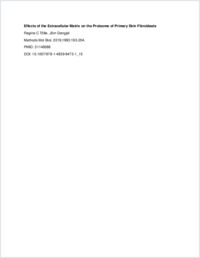Effects of the Extracellular Matrix on the Proteome of Primary Skin Fibroblasts
DOKPE
- Tölle, Regine C. University of Fribourg
- Dengjel, Jörn University of Fribourg
- 2019
Published in:
- Methods in Molecular Biology. - New York : Humana, 2019. - 2019, vol. 1993, p. 193-204
Skin
Fibroblasts
Protein kinetics
Decellularization
Extracellular matrix
Proteomics
GASP
High-pH reversed-phase chromatography
SILAC
Mass spectrometry
English
The cellular microenvironment often plays a crucial role in disease development and progression. In recessive dystrophic epidermolysis bullosa (RDEB), biallelic mutations of the gene COL7A1, encoding for collagen VII, the main component of anchoring fibrils, lead to a loss of collagen VII in the extracellular matrix (ECM). Loss of collagen VII in skin is linked to a destabilization of the dermal-epidermal junction zone, blister formation, chronic wounds, fibrosis, and aggressive skin cancer. Thus, RDEB cells can serve as a model system to study the effects of a perturbed ECM on the cellular proteome. In this chapter, we describe in detail the combination of stable isotope labeling by amino acids in cell culture (SILAC) of primary skin fibroblasts with reseeding of fibroblasts on decellularized collagen VII-positive and -negative ECM to study the consequences of collagen VII loss on the cellular proteome. This approach allows the quantitative, time-resolved analysis of cellular protein dynamics in response to ECM perturbation by liquid chromatography-mass spectrometry.
- Faculty
- Faculté des sciences et de médecine
- Department
- Département de Biologie
- Language
-
- French
- Classification
- Biological sciences
- License
-
License undefined
- Identifiers
- Persistent URL
- https://folia.unifr.ch/unifr/documents/325188
Statistics
Document views: 86
File downloads:
- Toelle_2019_final: 118
